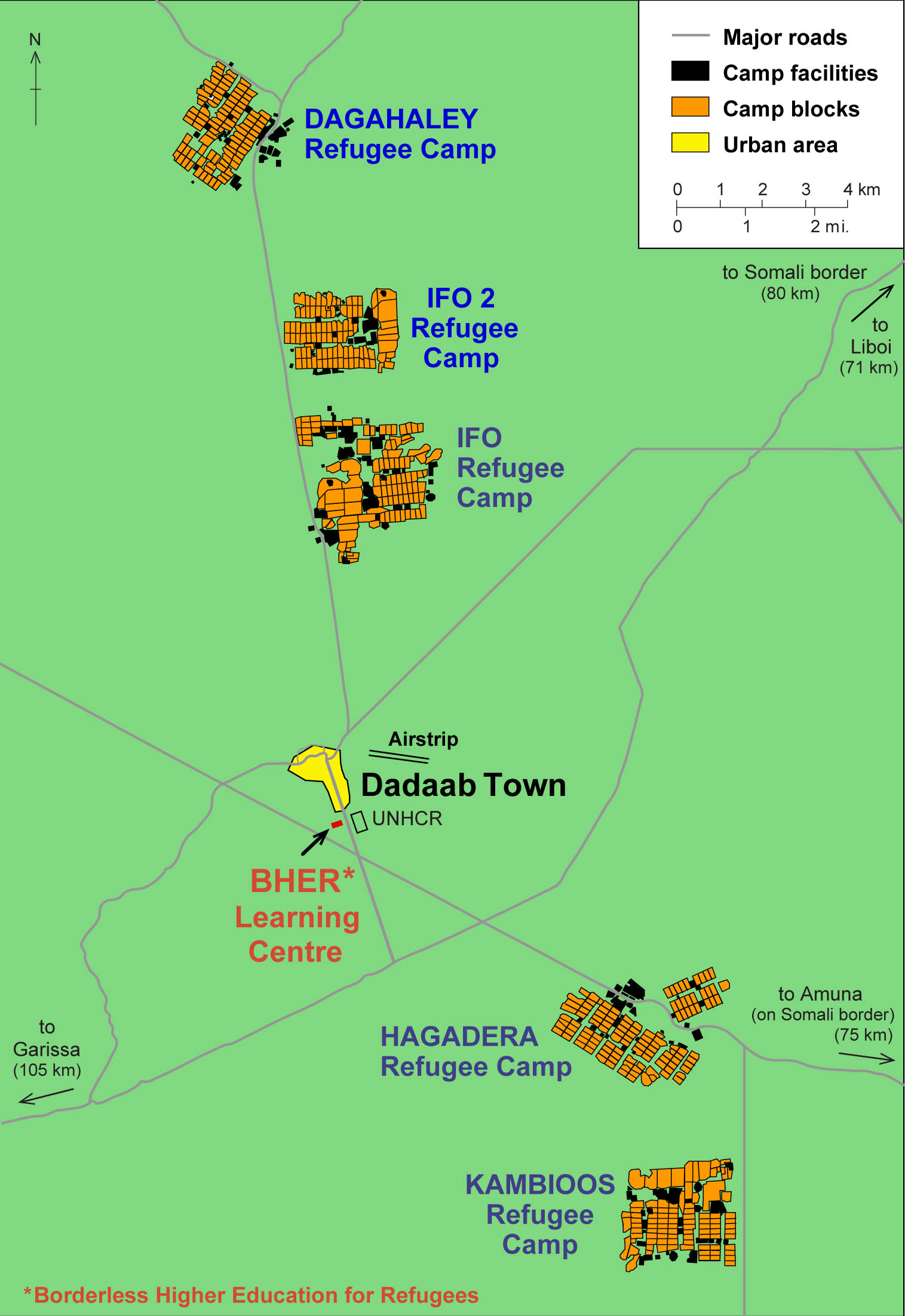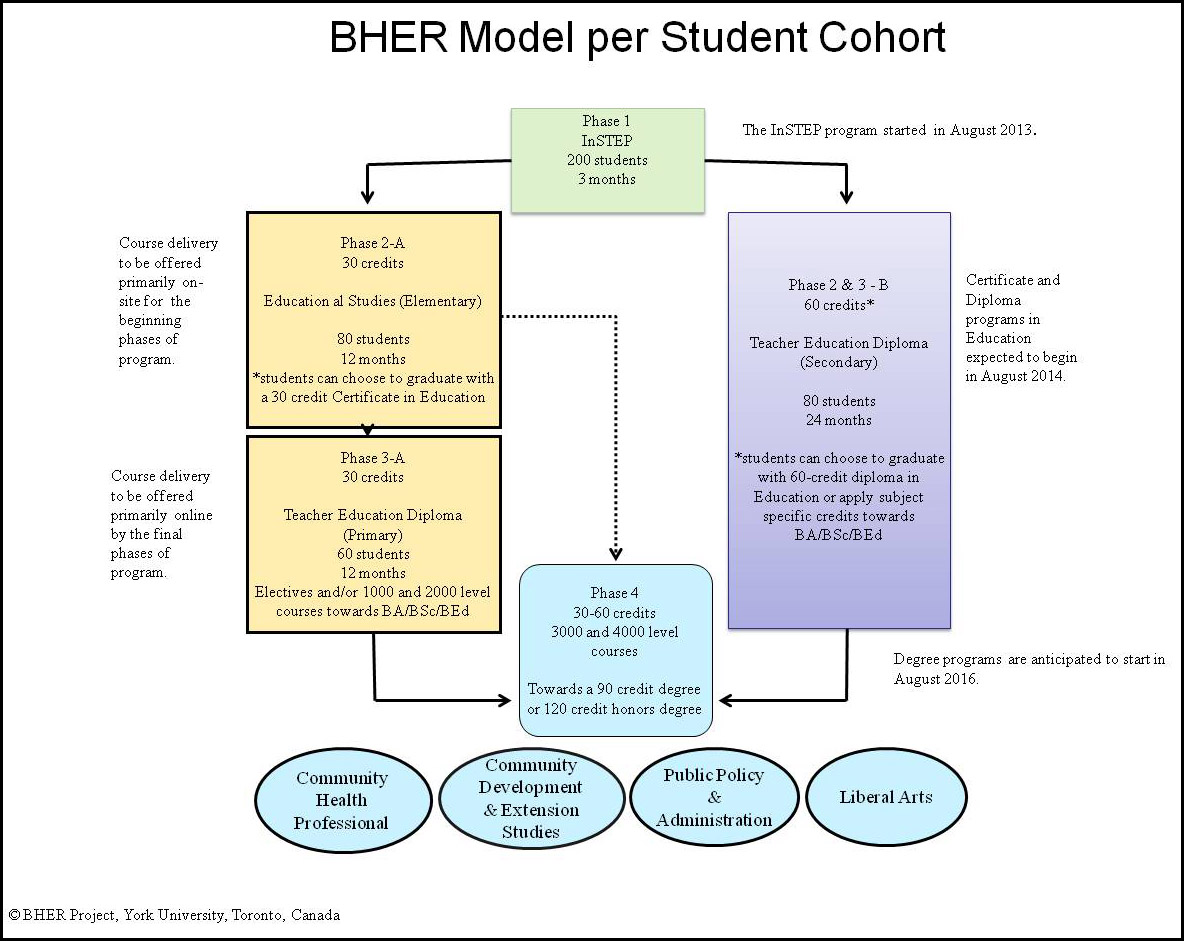Dadaab, Kenya is a town and region located about one hundred kilometres from the Kenya-Somalia border. There are six refugee camps within the region of Dadaab (Ifo, Ifo 2 East, Ifo 2 West, Dagahaley, Hagadera, and Kambioos), that stretch over 50 square kilometres in eastern Kenya.

BHER Learning Centre and the Dadaab Refugee Camps Garissa County, Kenya
Cartographic Office, York University, 2012 and Joseph Mensah
The first camp began operating in 1992 as a result of war in Somalia. Constructed to host 90,000 refugees, the original camp has been extended over the last 20 years to accommodate those fleeing continuing violence, and the environmental and social impacts of drought and famine in Somalia. Dadaab is now home to the largest group of refugee camps in the world, currently hosting well over 460,000 refugees, who have arrived from various countries, mainly Somalia (95.8%) and Ethiopia (3.9%), but also from Sudan (.2%). In the last year alone, the population of the camps has doubled due to intensified conflict in Somalia.
More than half of the refugees in the camps are under 18 years of age (Table 1). Unfortunately, education in the camps and in the Dadaab region as a whole is limited.
Those who can pursue an education, often limited to elementary school, face large class sizes, scarce access to materials and sanitation facilities, and limited instruction in many cases by teachers with insufficient training. While some schools are staffed by Kenyan nationally certified teachers, the majority of teachers are refugees themselves who have received only elementary or secondary education. Of those that complete their primary school exams, even fewer can attend secondary school.
There are nearly equal numbers of school-aged boys and girls, though girls represent the minority of enrolled students at both the elementary and secondary level. As of July 2012, girls accounted for only 40% of students enrolled at the primary level and 23% at the secondary level.[1]
Considering girls have fewer opportunities to access and complete their education, they also have disproporaionately fewer opportunites to pursue employment or earn scholarships for further study.The project aims to work with girls and the wider community to support girls’ education and mitigate the socio-cultural barriers they face that prevent them from pursuing an education.
| Dadaab Regional Overview | ||
| Demography of Somali Population | ||
| Male (50%) | Age | Female (50%) |
| 9% | 0-4 | 8% |
| 14% | 5-11 | 13% |
| 7% | 12-17 | 6% |
| 18% | 18-59 | 21% |
| 2% | 60+ | 2% |
| Table 1 – Source: UNHCR 2012 | ||
Often seen as subordinate to boys, girls are responsible for the majority of household domestic work, with school considered a lesser priority. Facing the challenges of poverty girls are often required to supplement family income by taking jobs or staying home so other family members can work. Early marriage practices makes pursuing an education remote for many girls. Additionally, the potential health consequences of female genital mutilation and a lack of sanitary napkins and privacy at school latrines often results in girls being absent from school. When they do have the opportunity to attend school, their marginalization is further manifest in their general reticence and reluctance to ask questions in class.
There are two organizations already working to improve the educational opportunities for girls in Dadaab–the World University Service of Canada (WUSC) and Windle Trust Kenya (WTK). WUSC has been offering opportunities for top refugee students to study abroad in their Student Refugee Program and has been actively promoting girls education through its partnership with WTK. WTK has been connecting refugee students with sponsorships to study at Canadian and Kenyan universities and providing tailored courses within camp to improve the quality of the available primary and secondary education. To this end, the BHER project will build on the work done by the World University Service of Canada (WUSC) and Windle Trust Kenya (WTK) to actively promote girls education to help redress the marginalization of women within the camps
There is currently no opportunity for higher education in the camps.
A partnership between York University, Kenyatta University, the University of British Columbia and Moi University offers students the opportunity to earn internationally recognized certificates, diplomas and degrees. The BHER project brings these university partnerships together with WTK and WUSC, organizations already providing education in the camps. (For more information on the roll-out of programs, please see the Toronto Workshop 2012 Report or the Feasibility Study Report).
The BHER project aims to:
(1) improve the equitable delivery of quality education in refugee camps and adjacent local communities through university training opportunities which will prepare a new generation of male and female teachers; (2) create targeted, continuing opportunities for young men and women in university programs that will enhance their employability through portable certificates, diplomas and degrees; (3) build the capacity of Kenyan academic institutions that already offer onsite/on-line university degree programs to vulnerable and marginalized groups.
The BHER project has four phases:
These programs will enhance the opportunities of vulnerable youth from refugee and marginalized communities, and build educational and teaching capacity. Our ultimate goal is to afford refugee youth, especially girls, a greater likelihood of successful and productive repatriation to their home country when possible. We envision a rise in the quality of education in host/home countries concerned with building peaceful, equitable and socially inclusive societies
For more information about the Dadaab camps, please consult the resources in our BHER In The News section, our Media archive or our RefWorks bibliography.
[1] UNHRC 2012 “Situation Report: Refugee Camps in North Eastern Province Alinjugur & Dadaab Sub-Offices July 17-31” Online resource, http://data.unhcr.org/horn-of-africa/download.php?id=974. Accessed August 2012.




